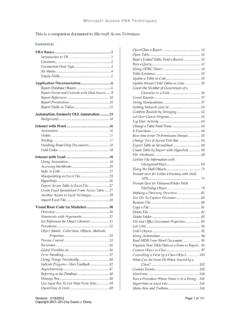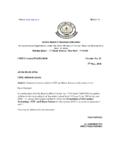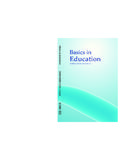Transcription of Microsoft Word: Visual Basic for Applications
1 Microsoft Word: Visual Basic for Applications See also: Access Techniques for VBA code techniques, some is specific to Access, some are general. This document presumes you know something about VBA. It is not a primer. It is my personal resource. CONTENTS. About Page Headers and 30. Organizing Macros ..3. Export and Import Code ..3 Assembling Multi-file Documents .. 32. Get to Know the Object Model ..3 Approach ..32. Code Samples ..33. Miscellaneous Subjects ..4 Prompt User for Directory of New File .. 33. Insert Chapter 33. Anatomy of a Word Document ..4 Insert Section Break Odd 34.
2 Moving Around in a Word Document ..4 Update Main Table of Contents .. 34. Working with Documents ..6 Update Main Table of 34. Working with Templates ..7 Save New Document .. 34. Update Chapter Tables of 34. Working With Update Indices .. 34. Working With Styles ..7 Delete Macros in New Document .. 35. Working With Subroutines .. 35. Working With 36. Portrait and Landscape ..13. Shapes .. 36. Document About Page Anchoring a 36. Positioning a Shape .. 37. Working with Tables ..16 Formatting a Shape .. 37. Addressing Table Cells ..19 Other Important Shape 37. 37. Dialog Converting Visio Picture into Inline Shape.
3 38. Message Box Key Present RelativeVerticalPosition Property .. 38. Prompt User for Choices ..21 RelativeHorizontalPosition 38. Top Property .. 38. Dialog Object ..21 Left Property .. 39. Prompt User for File(s) or Directory with FileFind Dialog Shrink Inline Shapes ..40. FileDialog Object ..23. Prompt User to Select Folder with FileDialog Watermarks .. 42. Background Printed Watermark ..42. Watermark as Text Box ..43. Documenting Your Shortcut Code Created by Insert Print Watermark About Keyboard Shortcut Background Run This Code ..25. DOM Background ..26 Iterative Document Editing.
4 45. Reformat Text in Square Brackets ..45. Field Codes in VBA ..27 Insert RD Field Codes ..46. Index Change Styles in all Word Files in a Given Table of RD Field Code ..29. Field Codes and Page Numbers ..30 Passwords and Protection .. 50. Revision: 8/11/2011 Page 1 of 59. Copyright 2002 2011 by Susan J. Dorey Microsoft Word: Visual Basic for Applications Interacting with an Access Iterating Procedures in Modules ..55. Basic Logic to Inventory Macros ..56. Automation ..52. Inventorying Files .. 56. Inventorying Macros ..52 Relevant Relevant Object Revision: 8/11/2011 Page 2 of 59.
5 Copyright 2002 2011 by Susan J. Dorey Microsoft Word: Visual Basic for Applications ABOUT MACROS. Recording keyboard actions is a good way to get the needed code, then you can edit it into an efficient macro. Organizing Macros Macros (in newer versions of Word) are stored in modules. They may reside in any kind of Word file, document or template. All the macros in a file comprise a Project. By default new recorded macros are created in the NewMacros project of It can be helpful to organize macros into modules. Perhaps you put all macros used together in the same module. Perhaps you put utility macros, like those that transpose two adjacent characters, in the same module.
6 But if you have 100 macros, it is better if they are distributed across 5 or so modules. You can create a module in the VBA editor with menu Insert, Module. You can rename a module: First select the module, then use menu View, Properties Window. to open the same-named window. Properties are listed in tabular format with the names in the left column and the values in the right column. Select the value for the Name property and retype it. Click elsewhere for it to take effect. You can move a macro from one module to another: In the Code window select the text of the macro, cut it, open the Code window of the new module, position the cursor, and paste the text.
7 You can delete a module: select it then use menu File, Remove. Export and Import Code A module's code can be exported as a .bas text file. Such a file can be imported into a different project. This can be a convenient method for copying code from one Word file to another. Get to Know the Object Model Because VBA is an object-oriented language, you will be most effective if you understand the Word object model and how to manipulate it. Basically the model has objects. Objects are grouped into collections which are an object unto themselves. Objects may have child objects and/or parent objects.
8 Objects also have methods and properties. When you are trying to figure out how to do something, you must identify the relevant object and property or method. Sometimes you start with the property or method and work backward to the object. Look in the help file for a diagram. Revision: 8/11/2011 Page 3 of 59. Copyright 2002 2011 by Susan Dorey Designs Microsoft Word: Visual Basic for Applications MISCELLANEOUS SUBJECTS. Anatomy of a Word Document When you are editing a Word document with VBA, it can be important to understand the different parts objects and how to deal with them.
9 You could study the Word Object Model, which you can find in the VBA Help file. Key objects that I have needed to handle include: Object Parent Object Contents Window Application all the (open) windows Pane Window the window panes for a given window Document Application an open document Section Document sections are used to hold text formatted differently than the base document, including multiple columns and different page orientation and/or margins Footnotes Document There are special properties that return a particular object: ActiveDocument. Returns a Document object for the document that is active, , the document with the focus.
10 ActiveWindow. Returns a Window object for the active window, , the window with the focus. ActivePane. Returns a Pane object for the active pane in specified window. SeekView. Returns or sets a View object with the document element displayed in print layout view. It uses the WdSeekView constant to specify which view: main document, header, footer, endnotes, footnotes. There are several variations of header and footer: current, first, even, primary. This property can incur a run time error of 5894 if the view is not Print Layout. Examples: = wdSeekMainDocument If <> wdSeekMainDocument Then.






